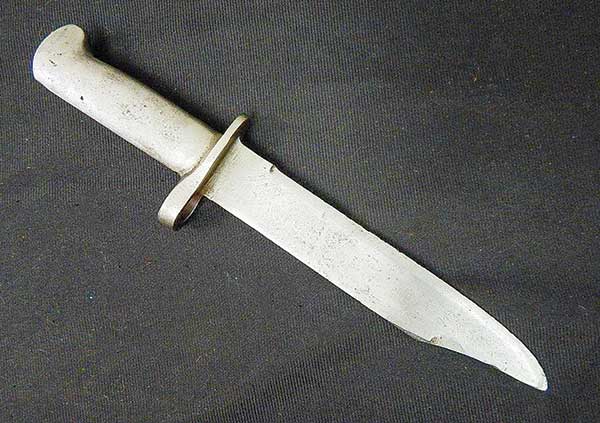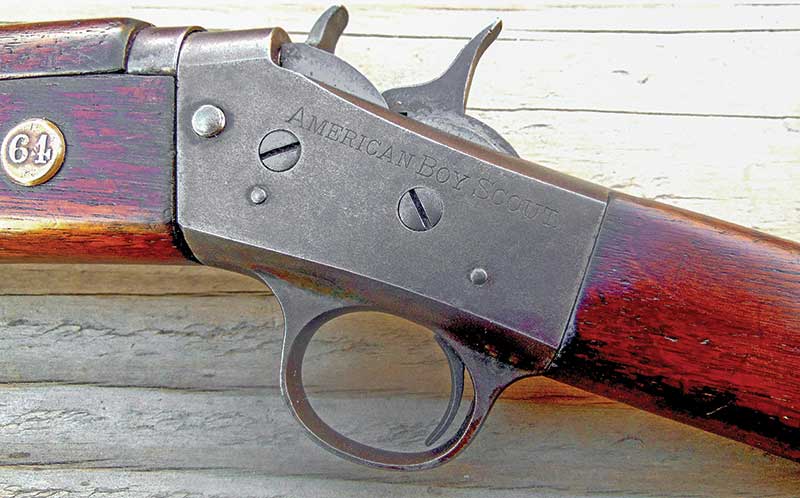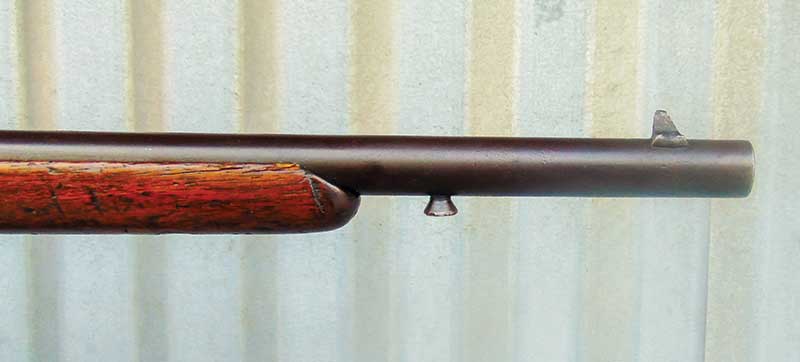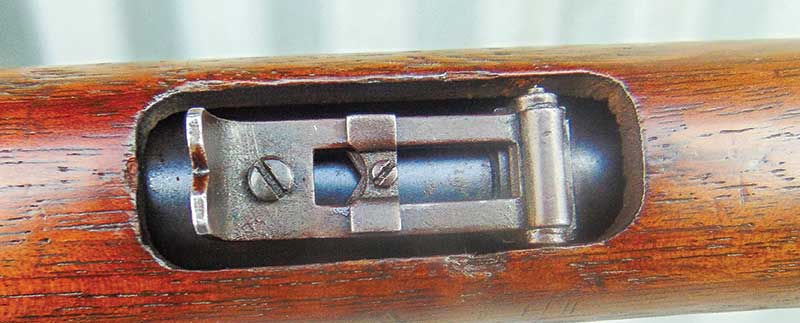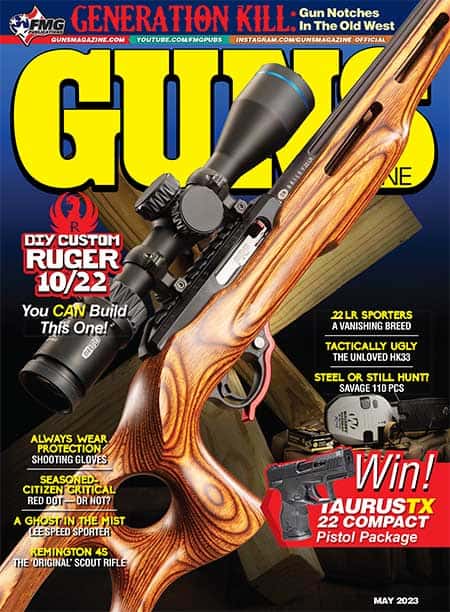Remington No. 4S Rolling Block
The First ‘Scout Rifle?’
Remington’s Rolling Block — a simple, efficient single-shot action developed in the mid-1860s — served as an interim system worldwide (along with the Peabody Martini) until the eventual ascendance of the bolt-action as a military service rifle.
Although a quintessentially American design, it was used in various centerfire chamberings by Denmark, Sweden, Norway, Spain and many other nations. It saw service in the Indian Wars, the Mahdist War in Egypt, the First Italo-Ethiopian War and with countless buffalo hunters in the American West.
However, the Rolling Block in a scaled-down rimfire format — specifically the No. 4 series — lasted until the early 1930s when demand for repeating Remington .22s, both bolt and slide-action, forced the abandonment of the workmanlike Rolling Block system. But there was a very interesting stop along the long ride to obsolescence.
Scaled For Scouting
As part of Remington’s No. 4 Rolling Block series, the Remington No. 4S Musket in .22 Short served as the official rifle of the American Boy Scouts. No, we’re not talking about the better-known and far more successful “Boy Scouts of America,” (BSA) but an organization put together in part by newspaper titan William Randolph Hearst.
Founded in 1910, the American Boy Scouts (later referred to as the “United States Boy Scouts” to avoid confusion with the BSA), was defunct by the early 1920s. The peak membership was a comparatively anemic 17,000. Their motto was Semper Paratus (Always Prepared), similar if not identical in philosophy to that of the BSA’s “Be Prepared.”
Examination
The scout rifles were only made for one year — 1913. According to the Remington Society of America, “The total quantity made is unknown, but may be as many as 1,500.”
Our Remington Model 4S American Boy Scout features a blued 28″ round barrel. The frame is case-colored. The walnut, musket-type stock sports a single barrel band and came with the original leather sling. The original price was $5, but things have changed considerably. Value estimates from specimens I’ve seen range from $1,000 up to $1,500 and beyond. And there is a bayonet lug!
If you’re fortunate enough to encounter an original 6.5″ knife-style bayonet, be prepared to dig deep, quite possibly for more green than you paid for the rifle itself. James J. Grant offers a wry theory as to the scarcity — and consequent collector value — of the American Boy Scout bayonet:
“Evidently, not very many, if any, mothers wanted junior to have a sticker on the end of his new rifle, so these bayonets, if purchased at all, were surreptitiously disposed of.”
Despite the short shelf life of the 4S American Boy Scout and its “sticker,” the basic Model 4 Rolling Block furnished solid returns for Remington for many years. According to Bill Ward, in his Walnut and Steel II: More Vintage .22 Rifles: “All Model 4 rifles were discontinued in 1932. Sales had been disappointing for its last several years. Bolt actions could be made much cheaper and with at least comparable accuracy, and that’s what the shooting public wanted anyway. At least 350,000 Model 4S were produced over its 42-year life span, so despite waning sales toward the end, it was a highly successful rifle for Remington.”
Single-Shot Session
During our initial range session, we were curious over what kind of velocities we’d get from the “old timey” 28″ barrel. With the 29-grain Winchester Super-X Small Game load rated at 1,095 fps, we got 1,113 fps. Switching over to CCI 27-grain Varmint load, listing at 1,105, we averaged 1,088 fps. Just for fun we tried some 29-grain CCI CB Caps, rated at 710 fps, which averaged 639 fps! If there’s a lesson here, it would appear extra-long barrels don’t always furnish a velocity boost from the teeny-tiny .22 Short case.
Our accuracy evaluation was done at 25 yards from a sandbag rest. The American Boy Scout gave us good results with the Winchester Super X and CCI Varmint offerings, which printed 5-shot groups of just under an inch and just over an inch respectively.
This might not sound terribly exciting and the general consensus was the rifle would have logged more impressive results had the sights been a bit, well, larger. A small post front and minuscule V-notch rear might have been okay for the eyes of a 15-year old Scout back in the day, but for us geezers, acquiring a consistent sight picture was a challenge.
The rear sight sits in a cutout in the upper handguard and a small amount of elevation adjustment is possible. But any windage adjustment requires drifting the front sight. In contrast to the deficiencies of the sighting arrangement, however, the trigger was excellent, breaking at a very clean 4 lbs. and we had no issues with the lock time of the beefy external hammer.
But in our defense, results with the American Boy Scout pretty much met current merit badge accuracy requirements listed on the Boy Scouts of America website:
“Using a .22 caliber rimfire rifle and shooting from a benchrest or supported prone position at 50 feet, fire five groups (three shots per group) that can be covered by a quarter.”
Functioning, as you might expect from anything as solid and simple as a Rolling Block action, was flawless. The only difficulty worth noting was in handling those tiny cartridges on a cold day.
The sensation of lighting off a .22 Short in a rifle the size and weight of a No. 4S is a curious one. Wearing ear protection, it’s difficult to determine if the rifle actually went off. The anemic noise signature, even with high-velocity ammo, resembles the muffled snapping of a twig — and a wet twig at that.
An Indefinable Something
The No. 4S American Boy Scout rifle embodies a wonderful, hard-to-pin-down characteristic you’ll occasionally find with vintage guns if you’re lucky enough to fool with enough of them.
You could call it the “Coolness Factor.” As half-assedly trendy as the term has come to be, here’s my feeble defense of it: If you’d have told me beforehand a 7-lb. single shot in .22 Short — using an antiquated single-shot action — would be as captivating as this one turned out to be, I’d have laughed. But after having shot it, I’m definitely not laughing. And every one of my shooting buddies who did a bit of bench time with the rolling block felt the same way. The rifle is an absolute hoot!
As an intriguing — if short-lived — member of the No. 4 “family,” the 4S American Boy Scout rifle remains a quiet, recoilless, highly desirable and very shootable artifact.

